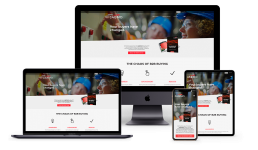Jabmo Case Study
Jabmo is a well-known company that is changing the face of B2B marketing. They have pioneered a whole new approach to account-based marketing with their hyper aware platform and integrated suite of ABM applications.
1. Pre-Forci times
The previous Jabmo website was built using a premium template that relied on Visual Composer and a lot of shortcodes to display the different pages and their elements, which made it hard for the content managers to create or edit pages properly.
2. Onboarding
We started lean – at first, we worked together with Jabmo on their previous WordPress website for a few months before it was decided to create a completely redesigned version with extended content management capabilities.
3. The design process
We had to keep all the old website content in a way that didn’t affect the SEO ranking, so we planned all the page mapping to the new structure with redirects and appropriate markup.
We also had to build an easily extendable website. For this, we applied our know-how in the field and planned a solid component-oriented base on top of WordPress.
Because of the market specific requirements, we suggested that it would be better to find and work with a US-based graphic design agency with a lot of experience in the target market itself. Several meetings were organised with Azalead and the design agency to clear all aspects of the design. In less than a month, the design arrived, and we started to work on the coding.
4. Coding
As we wanted to have completely customised components that would be easily extendable, we didn’t use any front-end frameworks, and we wrote the whole website markup, which also provides faster browser rendering and a better score in the website speed tests.
Together with the front-end, we started working on the WordPress installation and setting up the custom theme. We used the database from the previous WordPress website as a starting point, but we needed to clean it up and to update it to work with the latest version of the system. This allowed us to preserve all the existing pages and links, but again, as the previous theme relied on Visual Composer, we needed to manually update the content of the pages later on to suit the new website and its improved features.
As we had a tight deadline, we started with additional manpower for the front-end development so that we could move as planned. As usual, we used SASS to write our styles, and as we were building everything in a component manner, it was really easy to have two developers working on the same front-end simultaneously. As soon as any part of the front-end was completed, it was passed for integration with WordPress. That way, we managed to complete the WordPress installation, setup, and front-end and have a ready theme in less than three weeks.
The next step was to update all the content and complete the testing before releasing the website to production. That part was done by our content editors working together with the Azalead team. We removed a lot of the existing pages and updated the content of the ones that we kept.
The new administration was built in such a way that for every individual element of each component there was a different field in the administration. Thus, we made sure that the content managers didn’t need to handle any HTML markup, which is an important factor in eliminating any chance of the layout being broken by mistake.
Later, website personalisation was integrated into the homepage slider to display specific content based on the visitor’s IP address. This is actually part of the service that Azalead offers, and we integrated Azalead’s API with WordPress, where we made some website-specific improvements. All information that comes from the API can be mapped from the WordPress administration so the output on the website can be customised even more.
5. Releasing and testing
We had to release the website around the Christmas holidays which is why it needed to be fully tested before then. We also included our usual zero downtime deployment procedure, so we could release new features easily without any downtime.
6. Training
After the release, we held a training session with the Jabmo team and their content managers on how to add, update and control the appearance of the website content.
7. Result
The overall result was that Jabmo had their website inherited by us and completely rebuilt in a way that matches all the best practices and allows the team to manage the content easily and quickly without the fear of breaking anything.
8. Continuous development
Today, we continue to support the website, constantly improving it, extending its functionality and developing new pages. This makes Forci part of the Jabmo team, always ready to respond professionally and in a timely manner whatever the issue or support request.
In 2018, as part of this service, we completely rebranded the website with the new Jabmo logo and colours (previously it had been Azalead), a process that was fairly straightforward thanks to the foundations we’d laid during the initial redesign. The rebranding itself was closely coordinated with the Jabmo team and was released together with all other planned media releases. We’ve also added the necessary redirects from the old domain name to the new one, keeping the SEO and the visitors intact.
